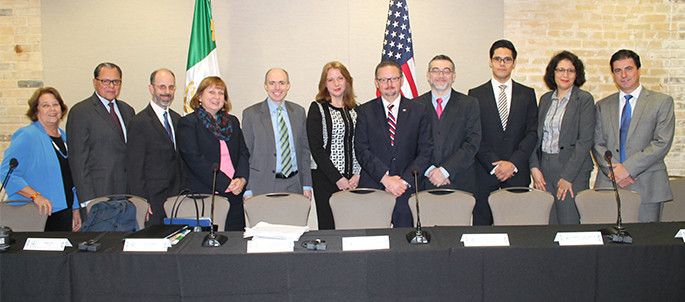NADB-BECC Board of Directors approve more than US$260 million for 14 projects in 2015

- Grant agreements signed for two water-related projects
- Proposed amendments to the charter for integrating NADB and BECC are being finalized
San Antonio, Texas – The Board of Directors for the Border Environment Cooperation Commission (BECC) and the North American Development Bank (NADB) held its semi-annual meeting and reviewed 2015 results for both institutions, which included the certification of 14 environmental infrastructure projects along the U.S.-Mexico border, representing a total estimated investment of more than US$833.6 million. Additionally, during the meeting, the Board approved a resolution doubling the capital of the Bank—US$450 in paid-in capital and the remainder in callable capital—subject to the legislative authorization processes of both countries.
These 14 projects are receiving US$239.2 million in NADB loans and US$18 million in grants. Among the projects approved, were three wind farms in Mexico—two in Tamaulipas and one in Coahuila—which will have a combined generation capacity of 298.5 megawatts (MW), as well as the first industrial emissions control project for a steel mill in Monclova, Coahuila.
In the water sector, four U.S. communities will receive US$17 million in grants through the Border Environment Infrastructure Fund (BEIF)—which is funded by the U.S. Environmental Protection Agency (EPA)—for implementation of a water distribution improvement project in Mesilla, NM and three wastewater collection and/or treatment projects in Brownsville, TX, Sunland Park, NM and Willcox, AZ.
During the meeting, management also reported that the Bank is expected to have disbursed a total of US$253 million in loans for the year, which will bring its outstanding loan portfolio to an estimated US$1.33 billion, a 12% increase over the balance at the end of last year.
Additionally, the Board received a report from NADB and BECC management regarding the progress made in the integration of the two organizations, including processes undertaken to merge the project development and technical assistance programs, as well as internal operations, without disrupting their ongoing activities in support of border communities.
Likewise, the Board received an update on an impact assessment of several wastewater projects implemented in four communities in Baja California. While the final report is not expected until the spring of 2016, preliminary results indicate, for example, that the increase in sewer hookups has reduced the use of latrines in Tijuana by 90%.
“We are pleased to see the substantial progress made by NADB and BECC in the integration process,” stated Maria de los Angeles Gonzalez Miranda, Board Chair and Head of the International Affairs Unit at Mexico’s Ministry of Finance. “The amended charter is ready to be sent for formal legal review, and the preliminary work that the two institutions are doing to merge their project development programs and other operations will facilitate its implementation.”
During the public session of the meeting, two financing agreements totaling US$1.0 million were signed for grants from the NADB-funded Community Assistance Program (CAP). The City of Nogales, Arizona, received a US$500,000 grant to replace the water distribution main on Crawford Street, and the Municipality of Sabinas, Coahuila, received the second grant, also for US$500,000, to support rehabilitation of its downtown sewer system.
In addition, NADB and the Monterrey Technological Institute (ITESM) signed an agreement to implement a diploma-level training program developed by NADB through its Utility Management Institute (UMI), which will be taught by ITESM’s Latin American and Caribbean water center, Centro del Agua para América Latina y el Caribe (CDA) and its School of Government and Public Policy (EGAP).
Through UMI, NADB offers an annual program of seminars to strengthen the administrative, financial and leadership skills to manage the water utilities located along the U.S.-Mexico border. In 2016, this program will be offered at EGAP’s facilities in Monterrey, Nuevo Leon, to utility personnel from Mexico’s northern border states. Upon completion of the 100-hour program, participants will receive a diploma from ITESM.